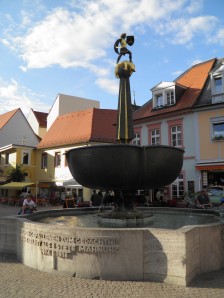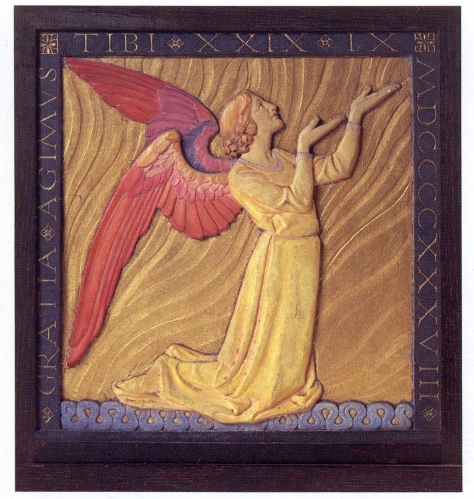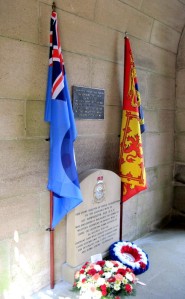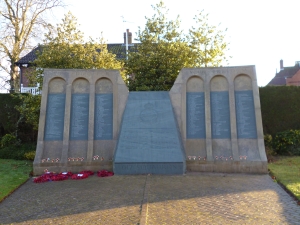by Roger Smither, IWM Research Associate
On holiday in Germany in September 2012, I noticed the St Georgsbrunnen, a striking war memorial fountain in the city of Speyer: water flows into a stone basin from a large metal bowl surmounted by an obelisk topped by a statue of St George slaying the dragon. Although St George is strongly identified as England’s patron saint, he is also one of Germany’s; he is also associated with soldiers and chivalry, so the use of his image on a German memorial should not be considered particularly surprising.

Speyer First World War memorial, Germany (©Roger Smither).
It was not just the memorial that caught my attention, however, but also the fact that the authorities had put up a plaque nearby offering a kind of apologia for it. Translated, this says: ‘The fountain was erected in 1930 as a memorial to the fallen of the First World War. The inscriptions and reliefs are an expression of the spirit of that time.’ It then notes that ‘The city of Speyer’s memorial for the victims of war and violence has, since 1985, been located in the northern Cathedral Garden.’
This struck me as sufficiently unusual to invite a closer look. Do the inscriptions and reliefs on the fountain obviously invite controversy or demand an apology?
There are four inscriptions on the stone basin of the fountain, three of which were originally illustrated by accompanying relief sculptures.
The main inscription reads ‘UNSEREN GEFALLENEN ZUM GEDACHTNIS UND UNS SELBST ALS STETE MAHNUNG 1914+1918’, which may be translated as ‘In Memory of our fallen and as a reminder to ourselves’ – a common sentiment for a war memorial, and scarcely contentious.
The other three inscriptions are all quotations from songs or poems.

St George and the dragon, Speyer First World War memorial, Germany (©Roger Smither).
One offers the first two lines of Der gute Kamerad (The Good Comrade), a poem written by Ludwig Uhland in 1809 – ‘ICH HATT EINEN KAMERADEN, EINEN BESSERN FINDST DU NIT’ (I had a comrade, you won’t find a better one). Set to music by Friedrich Silcher In 1825, the poem long pre-dates the ideologies of the 1930s, and remains the traditional mourning song of the German Army. The accompanying relief illustrates the line – one soldier falls wounded in a marching group.
The second reads ‘DEUTSCHE FRAUEN, DEUTSCHE TREUE’ (German women, German loyalty), and is taken from the second verse of the Deutschlandlied – ‘Deutschland, Deutschland über alles’ – written by August Heinrich Hoffmann von Fallersleben in 1841. This verse is little known these days, but it is ignored more because of its male chauvinist tendencies than because of its nationalism: it equates women with wine as inspirational pleasures of traditional Germany. This time, the accompanying relief shows two women digging in a field, to symbolise the home front war effort.
The third inscription reads ‘DEUTSCHLAND MUSS LEBEN AUCH WENN WIR STERBEN MÜSSEN’ (Germany must live, even if we must perish), which is the closing line of each verse of a 1914 poem, Soldatenabschied (Soldier’s Farewell) by Heinrich Lersch. This does sound quite nationalistic, but English readers will recall Rudyard Kipling’s very similar line ‘Who dies if England live?‘ which comes at the end of verse 4 of his poem For All We Have and Are, also written in 1914. On the fountain in this case the accompanying relief is missing, but it is possible to find reproductions of old postcards on the web, where it appears that the sculptor had depicted two soldiers in a trench.

Modern inscription near the Speyer First World War memorial, Germany (©Roger Smither).
None of this seems hugely controversial. A search of the IWM’s War Memorials Archive database finds over 60 memorials in the United Kingdom with ‘Who dies if England live?’ as part of their inscription, and it is hard to imagine that the relevant local authority has thought it necessary to add an explanation or apology in any of those cases. As an example of even more overt nationalism on a British memorial, Frances Casey, Project Manager of the Archive, has drawn my attention to the one at Brierley Hill, which includes – without any hint of apology – the following text:
THIS MONUMENT / WAS ERECTED BY THEIR FELLOW / TOWN FOLK TO THE MEMORY OF / BRIERLEY HILL MEN / WHO LOYALLY GAVE THEIR LIVES / IN DEFENCE OF / COUNTRY AND CIVILISATION / AGAINST AGGRESSIVE / AMBITIONS OF / GERMANY / AUSTRIA & TURKEY / IN THE GREAT WAR

Brierley Hill First World War memorial (IWM WMA 17472, ©G A Cox)
With the help of Christa Rinner, a researcher based in Karlsruhe, I have learned that the memorial fountain in Speyer is the work of the architect Karl Latteyer of Ludwigshafen and a British-born sculptor named William Ohly, who both attended its official inauguration on 29 June 1930, and that – although there does not seem to have been any specific event in Speyer to prompt it – the explanatory plaque was added in 1996, when the need to replace some of the piping led to a full-scale restoration of the fountain.
There may not have been such an episode in Speyer but it remains true, of course, that war memorials can be controversial, and they have undoubtedly been the focus of protest elsewhere. Demonstrators in the former Eastern Bloc have often targeted Soviet war memorials with either hostility or derision, including an episode in Bulgaria in 2011 when a street artist painted the figures on the Soviet memorial in Sofia to represent American comic-book characters.
The Coalition invasion of Iraq in 2003 prompted a French protestor to spray-paint ‘Rosbeefs Go Home’ and other slogans on the cross of a CWGC cemetery at Etaples, and there was outrage in India in 2012 when protestors in Mumbai were photographed attacking the Amar Jawan Jyoti memorial which commemorates two Sepoys executed during the 1857 uprising.
More recently, the Animals in War and Bomber Command memorials in London were subjected to graffiti following the murder outside Woolwich Barracks of Drummer Rigby, 2nd Battalion, Royal Regiment of Fusiliers. I wonder, do war memorials present political statements in themselves? Why are they used as sites of protest? How often do civic authorities try to defuse objections before they are raised? It strikes me that the politics of war memorials could be an interesting topic for further research.

















